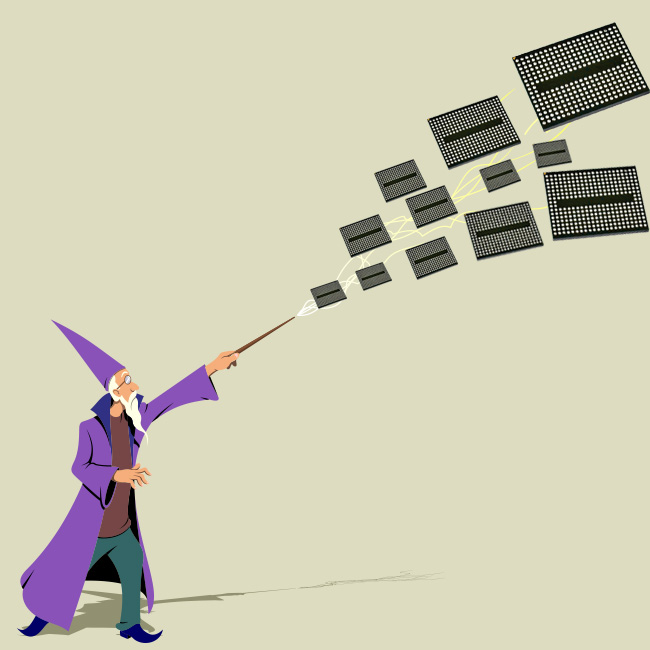For the uninitiated, low-density parity-check (LDPC) code is an error correction code (ECC) that is used to both detect and correct errors on data that is transmitted from one point to another. All ECC types include correction data, so when information is transmitted with errors, the receiver has enough information to fix the errors without having to ask the source for the data again.
This enables transmitted data to maintain a constant speed as is required with digital television signals. What you don’t want is for the image to freeze repeatedly while waiting for correction data to be sent multiple times.
LDPC code was first presented to the world by Robert G. Gallager at MIT in 1960. It was very advanced for its time and, as it turned out, required a fantastic amount of computation to use real-time. The problem was that back in 1960, vacuum tube computers of that period performed about 100 times less work than the microprocessor-powered computers of today. In 1960, you would need a computer the size of a 2,000-square-foot house to process the LDPC correction information in real-time. This was hardly economical, so LDPC was mostly lost for nearly 40 years, as other simpler codes took its place over that period.
What was old is new again
In the mid-1990s, engineers working on satellite transmissions for digital television dusted off the LDPC codes and started using them for real-time operations. By then, computer processing had seen dramatic reductions in size and costs. Fast-forward to the past 5 years: we have seen a major increase in LDPC development and use because it appears to be the best solution for high-speed data transmissions, especially those subject to heavy levels of electrical noise that induce higher error rates. Also, the processing power of target devices like WiFi receivers and HDDs has grown even stronger and faster than some of the main CPUs of a few years ago. This enables LDPC to be deployed for little additional cost with the advantage of real-time data correction superior to correction offered by simpler codes.
If you have seen one LDPC solution, have you seen them all?
Nothing could be further from the truth. For example, an LDPC solution designed for satellite communication cannot be used for HDDs since there is no direct porting of the code, though there are distinct advantages to the two engineering teams sharing their knowledge and experience through their development efforts. Take, for example, the LDPC code that LSI [the prior owner of SandForce flash controllers] has been shipping in its TrueStore HDD read channel solutions since 2010. When LSI acquired SandForce and started work on SHIELD error correction code (based on LDPC) for flash controllers, there was no direct porting of that HDD code to support SSDs. However, the HDD development teams knowledge and experience from creating the HDD code greatly improved the SSD teams ability to more quickly bring SHIELD technology to the next-generation SandForce flash controller.
How do LDPC solutions for SSDs differ?
Many LDPC providers claim that their offerings rival the capabilities of competitive solutions, though often they aren’t telling the whole story. All LDPC solutions start with what is called hard-decision LDPC – a digital correction algorithm that operates at line rate on all data passing through the correction engine. The algorithm uses the meta-data generated from the user and system data stored on the flash memory, and helps recreate the user data when the flash memory returns it with errors. Hard-decision LDPC catches most errors from the flash memory, though sometimes it can be overwhelmed by an inordinate number of errors. That is where soft-decision LDPC — a more analog-based correction algorithm — comes into play.
Can a soft-decision be strong enough for my data?
Soft-decision LDPC is an error correction method that looks at other information beyond the actual ECC data. Soft-decision, in a sense, looks at the meta-data of the meta-data. The simplest form of soft-decision LDPC may just re-read the data at a different reference voltage, as if asking a person can you say that again? More complex soft-decision might be compared to listening to a man with a heavy French accent speaking English. You know he just said something in English, but you could not clearly grasp what he said. You ask some questions and, from his answers, soon realize what he originally said and are now back on track. While this might seem more like guessing at the answer, soft-decision LDPC uses statistics to help ensure the answers are not false positive results. As a result, soft-decision LDPC uncovers a new set of engineering problems that need to be solved, opening new opportunities for flash controller manufacturers to create powerful intellectual property (IP). For that reason, you’re likely to learn very little about how a given company’s soft-decision LDPC works.
The 2013 Flash Memory Summit in Santa Clara, California, provided the first public demonstration of SHIELD Advanced Error Correction Technology. SHIELD technology includes hard- and soft-decision LDPC with digital signal processing (DSP) and a number of other unique features designed to optimize future NAND flash memory operation in compute environments. One feature, called Adaptive Code Rate, works with other SandForce controller features to enable the spare area in flash memory reserved for ECC data to occupy less space than the manufacturer allocation and then dynamically grow to accommodate inevitable increases in flash error rates. The soft-decision LDPC capability offers multiple strengths of correction, with each activating only as necessary to ensure the lowest possible real-time latency.
So its clear that all LDPC solutions are far from the same. When evaluating LDPC solutions, be sure to understand how they manage data correction when it exceeds the ability of the hard-decision LDPC. Also, make sure the algorithms are actually in use in a product. Otherwise, the product might turn out to be a science experiment that never works.








Leave A Comment